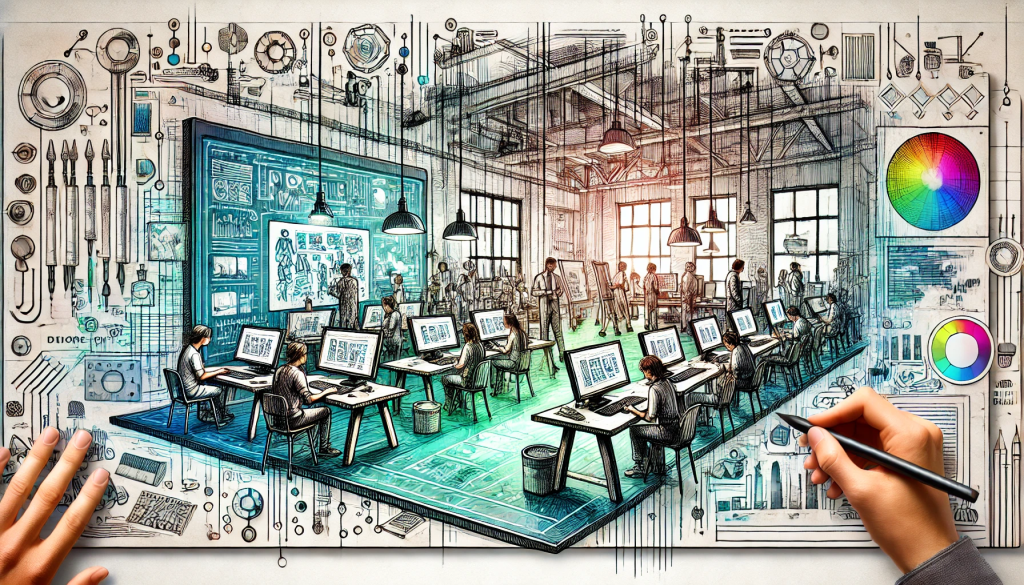In today’s digital age, artists have unprecedented opportunities to express their creativity through digital illustration. Whether you’re a beginner looking to start your artistic journey or a seasoned professional aiming to refine your skills, mastering digital illustration techniques can transform your artwork and open new creative possibilities. This guide explores essential approaches, tools, and practices that can elevate your digital art to the next level.
The Evolution of Digital Illustration
Digital illustration has come a long way since its early days. What began as basic pixel art has evolved into sophisticated digital paintings that rival traditional media in depth, texture, and emotion. The accessibility of powerful hardware and software has democratized digital art creation, allowing artists from diverse backgrounds to showcase their talents globally.
Modern digital illustration encompasses various styles—from sleek vector graphics to painterly digital compositions that mimic traditional media. Understanding the fundamental graphic design principles that underpin these styles is crucial for creating visually appealing and communicative artwork. These principles transcend the medium and apply equally to digital and traditional art forms.
Essential Digital Illustration Tools
Selecting the right tools is a critical first step in mastering digital illustration techniques. While talent and practice remain fundamental, appropriate hardware and software significantly impact an artist’s workflow and output quality.
Hardware Considerations
For serious digital artists, these hardware components deserve careful consideration:
- Drawing tablets: From budget-friendly options to professional-grade display tablets
- Computers: Systems with sufficient RAM and processing power
- Monitors: Color-accurate displays for precise color work
- Stylus pens: Pressure-sensitive tools that mimic traditional drawing implements
Software Options
The digital illustration landscape offers diverse software solutions, each with unique strengths:
- Raster-based programs: Ideal for painterly styles and photorealistic work
- Vector-based applications: Perfect for clean, scalable illustrations
- Specialized drawing software: Programs designed specifically for comics, manga, or concept art
- 3D modeling software: For creating three-dimensional illustrations
Many artists begin with industry standards like digital art software but eventually develop personalized workflows combining multiple programs. The key is finding tools that feel intuitive and support your artistic vision rather than limiting it.

Fundamental Digital Illustration Techniques
Mastering these core techniques will provide a solid foundation for your digital illustration journey:
Line Work Mastery
Creating clean, expressive lines is often the first skill digital artists develop. Consider these approaches:
- Experiment with brush settings to find the perfect line quality
- Practice with stabilization tools for smoother strokes
- Develop muscle memory through regular sketching exercises
- Learn when to use vector lines versus raster brushes
Color Theory Application
Understanding color relationships dramatically impacts illustration effectiveness:
- Build harmonious color palettes using color theory principles
- Explore color psychology to enhance storytelling
- Maintain color consistency across complex illustrations
- Master digital color mixing and blending techniques
Light and Shadow
Convincing light and shadow treatment creates depth and dimensionality:
- Study how light behaves in the physical world
- Practice creating consistent light sources in your illustrations
- Use shadow placement to anchor objects and create volume
- Experiment with atmospheric effects to enhance mood
Texture Implementation
Textures add richness and tactile quality to digital illustrations:
- Create custom texture brushes for unique effects
- Incorporate photographic textures strategically
- Develop techniques for simulating different materials
- Balance texture detail with overall composition clarity

Advanced Digital Illustration Approaches
Once you’ve mastered the fundamentals, these advanced techniques can elevate your work:
Composition Strategies
Strategic composition guides viewers through your illustration:
- Apply the rule of thirds and other compositional frameworks
- Create visual hierarchy to emphasize key elements
- Use negative space effectively
- Direct eye movement through leading lines and focal points
Digital Painting Techniques
For those pursuing painterly styles, these approaches prove valuable:
- Layer management for non-destructive workflow
- Blending methods that mimic traditional media
- Brush customization for signature styles
- Textural overlays for depth and richness
Stylization Methods
Developing a recognizable style sets your work apart:
- Experiment with abstraction and simplification
- Explore consistent character design elements
- Develop signature color palettes
- Balance realism with personal expression
Workflow Optimization for Digital Illustrators
Efficient workflows allow artists to focus on creativity rather than technical hurdles:
Structured Process
Following a consistent illustration process improves efficiency:
- Concept development and reference gathering
- Rough sketching and composition
- Refined line work
- Base color application
- Shading and highlighting
- Texture and detail enhancement
- Final adjustments and refinement
File Management
Organized file systems prevent frustration and lost work:
- Implement logical naming conventions
- Maintain regular backups
- Use version control for complex projects
- Organize assets and references systematically
Time-Saving Techniques
Strategic approaches maximize productivity:
- Create and save custom brushes and tool presets
- Develop and use personal reference libraries
- Learn keyboard shortcuts for frequently used commands
- Batch process routine tasks when possible

Common Challenges and Solutions
Every digital illustrator faces obstacles. Here are strategies for overcoming typical challenges:
Technical Limitations
When hardware or software constrains your vision:
- Optimize file sizes and resolution for your equipment
- Learn workarounds for program limitations
- Upgrade strategic components as budget allows
- Develop techniques that work within your technical constraints
Creative Blocks
When inspiration falters:
- Create prompt lists for quick inspiration
- Study diverse art styles to spark ideas
- Take breaks to refresh your creative perspective
- Join illustration challenges for structured practice
Skill Plateaus
When progress seems to stall:
- Request feedback from other artists
- Study masters in areas where you want to improve
- Take structured courses to fill knowledge gaps
- Set specific skill-building goals
Recommended Resources
To continue your digital illustration journey:
- Online communities dedicated to digital art provide valuable feedback
- Video tutorials focusing on specific techniques can address skill gaps
- Reference books on anatomy, perspective, and color theory build fundamental knowledge
- Artist showcases offer inspiration and insight into established workflows
Conclusion
Mastering digital illustration techniques is a continuous journey rather than a destination. Each project builds your skills and expands your creative vocabulary. By combining technical knowledge with artistic vision, you’ll develop a distinctive style that resonates with viewers and satisfies your creative ambitions.
The most successful digital illustrators maintain curiosity and a willingness to experiment, even as they perfect their craft. Remember that technical proficiency serves artistic expression—the techniques explored here are tools for bringing your unique vision to life. Keep practicing, stay inspired, and watch your digital illustration skills flourish.
